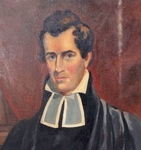University of Nashville
[3] The building no longer stands, but a Tennessee State Historical Marker was erected on the site.
[1][2] United States President Andrew Jackson served on the board of trustees for many years during this time.
[citation needed]' In 1850, all parts of the college level instruction were shut down, a consequence of a cholera epidemic in the city.
[6] He served as its headmaster when it moved to Nashville in the merger and continued in that capacity until the outbreak of the American Civil War in 1861.
[6] It was during this period that Sam Davis attended the Western Military Institute; he was later called the "boy hero of the Confederacy", and hanged by Union forces as a spy in 1863.
[8] In 1866, E. Kirby Smith was named co-chancellor of the University of Nashville, along with Bushrod Johnson, who returned to the school as a professor, to replace Lindsley.
[9] That year, a financial crisis was resolved when the Peabody Fund made a large donation, and the University of Nashville's operations were split into three different entities.
In 1914 the George Peabody College for Teachers purchased a new site adjacent to Vanderbilt University,[2] with over 50 acres (20 hectares) of wooded lawn.

